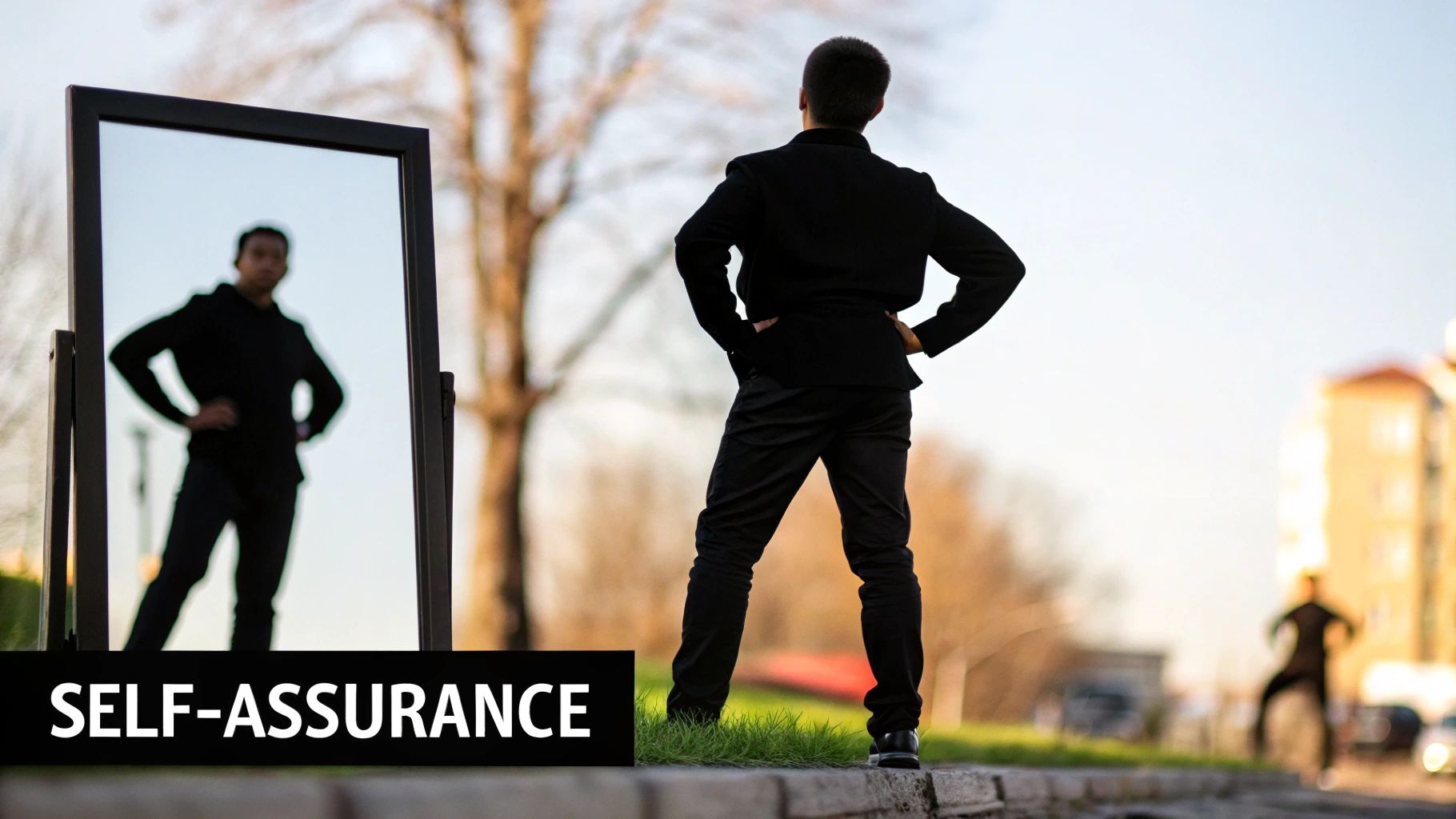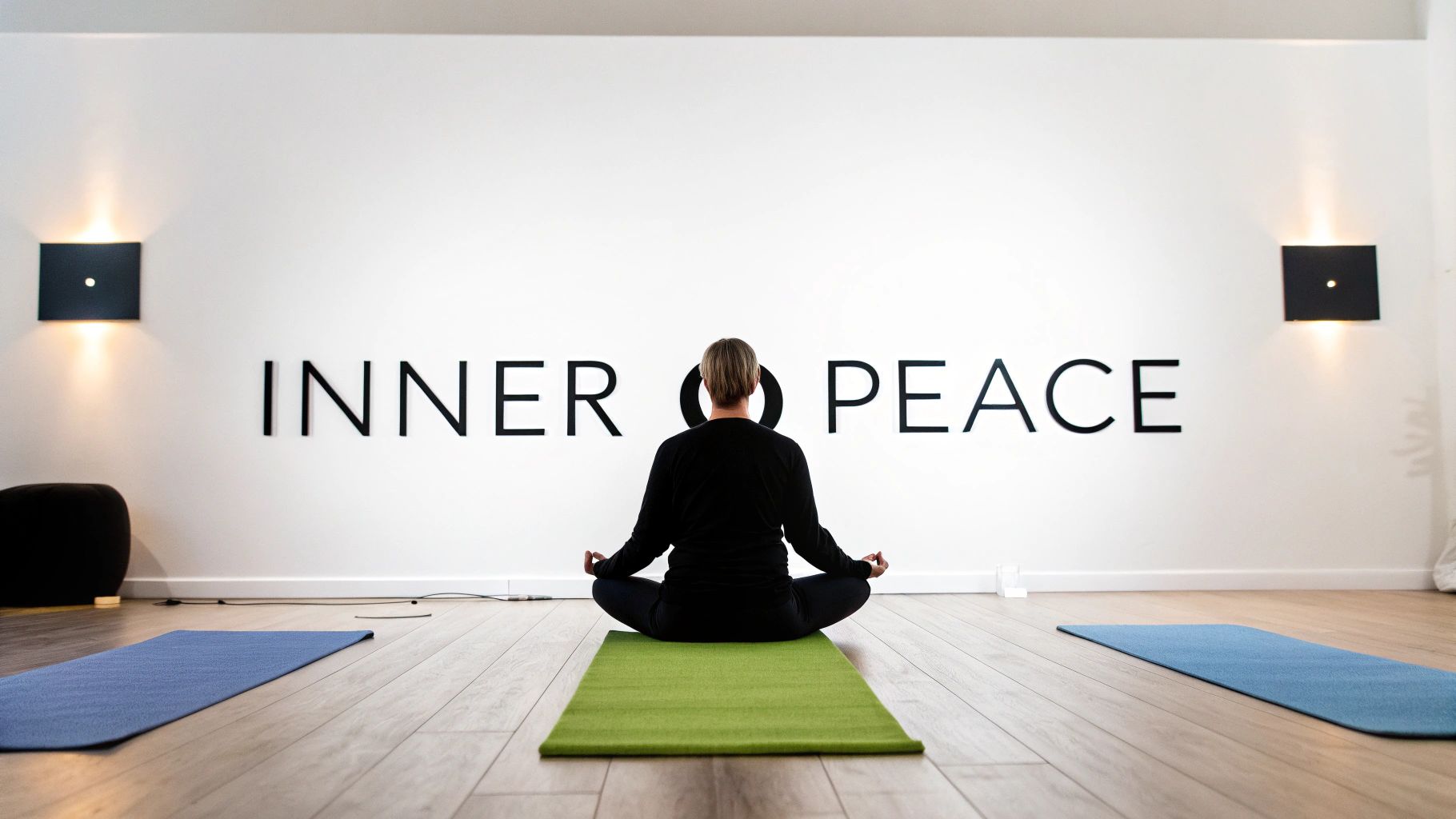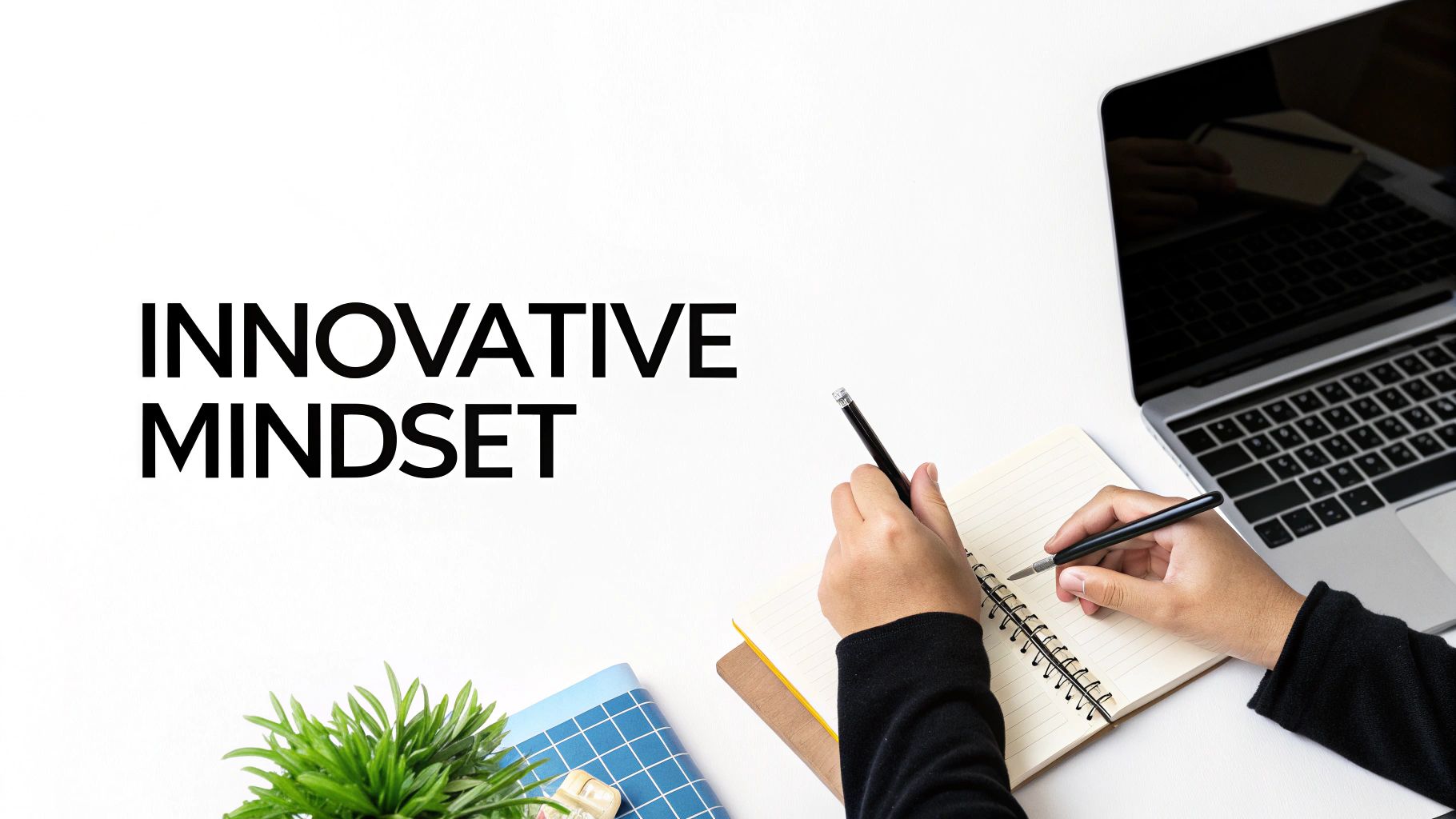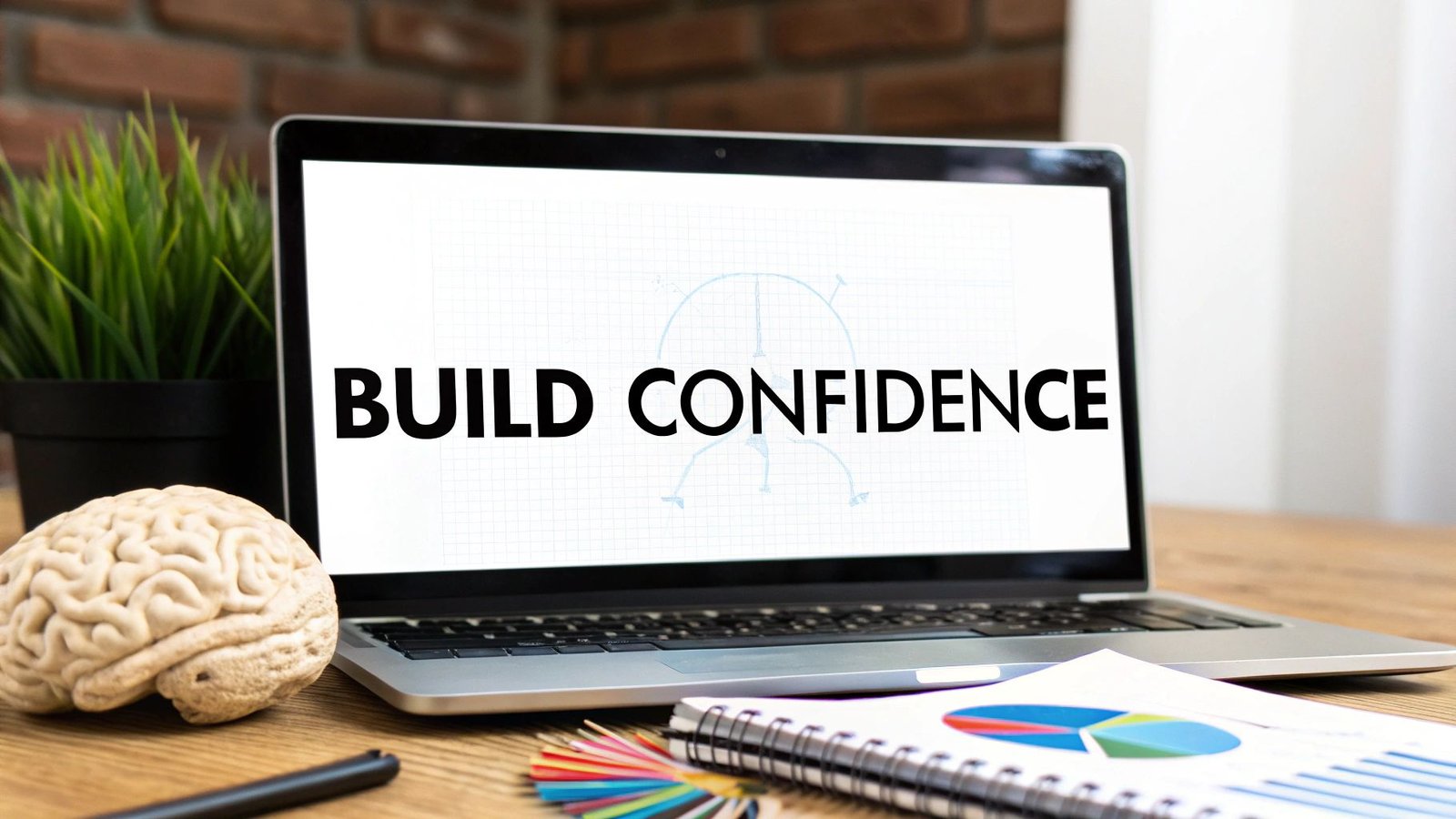Understanding Your Brain's Confidence Engine

Think of confidence as something concrete and measurable rather than mysterious. Your brain builds and maintains it through specific processes – like a finely-tuned engine that's always running in the background, processing your daily experiences and shaping how self-assured you feel. But this engine doesn't always work perfectly. Many popular confidence-building tips miss the mark because they don't account for how your brain actually develops confidence.
How Your Brain Processes Confidence
Your brain works like a meticulous researcher, gathering evidence from your daily life to form conclusions about what you can and can't do. Each experience becomes a data point that shapes your self-image. When you successfully lead a team meeting, your brain logs that as proof of your leadership abilities. But if you stumble during a presentation, that negative experience also gets recorded. The key lies in how you process these different experiences.
The Role of Interpretation
The way you make sense of events matters just as much as what actually happened. Two people can face the same setback but walk away with completely different beliefs about themselves. Take two students who fail a math test – one might think "I'm just bad at math" while the other concludes "I need to study differently next time." These different interpretations create very different effects on their confidence levels going forward.
Working With Your Brain, Not Against It
Once you understand how your brain builds confidence, you can work in harmony with these natural processes instead of fighting them. This means actively paying attention to your experiences and how you interpret them. Research shows that your brain uses patterns and statistics to generate confidence. Just like analyzing data tells you trends about a larger population, your brain uses individual experiences to form broader beliefs about your capabilities.
Practical Applications for Acquiring Confidence
You can put this knowledge to work right away. Start keeping track of your daily wins, even small ones, since they all contribute to your brain's confidence calculations. When setbacks happen, practice viewing them as opportunities to learn rather than proof of failure. This isn't about pretending everything is perfect – it's about building real confidence based on how you process both successes and challenges. Over time, this evidence-based approach creates lasting self-assurance that's grounded in reality rather than wishful thinking.
Making Friends with Decision-Making

The path to real confidence starts with mastering how you make decisions. When you're comfortable choosing a direction and trusting your judgment, genuine self-assurance follows naturally. Let's explore how decision-making and confidence work together to help you grow.
Understanding the Decision-Making Process
Your brain works like a natural information processor, taking in details and weighing options before making choices. While much of this happens behind the scenes, it shapes how confident you feel. Take the example of comparing job offers – your mind evaluates factors like pay, location, and growth potential. The more clearly you can see and prioritize these elements, the more confident you'll be in your final choice.
Why Some Decisions Feel Harder
We've all faced decisions that seem especially tough to make. Often, this happens when we don't have enough clear information to work with. Consider picking a career path – it's a big choice that affects many aspects of life. With so many options and unknowns, the process can feel overwhelming. The key is breaking these big decisions into smaller, concrete steps. Just like building anything complex, you start with the basics and work your way up, gathering information and setting clear goals as you go.
Building Your Decision-Making Muscles
Like any skill, you can strengthen your decision-making abilities through practice. Begin with everyday choices – what to eat for dinner, which way to drive to work, or when to schedule your meetings. Each time you make a choice and see it work out, your brain logs that success, building your confidence bit by bit. Scientists have found that our brains actually process these experiences much like they would analyze data in a study, using each outcome to build trust in our judgment.
Strategies for Confident Decision-Making
To feel more sure about your choices, try using simple tools to organize your thinking. A decision matrix, for instance, helps you list out what matters most and score your options fairly. This gives you solid reasons behind your choices rather than just going with your gut. It also helps to get input from people you trust – they might spot things you missed or share experiences that make your choice clearer.
Embracing the Imperfect
Remember that even the best decisions sometimes lead to unexpected results. This doesn't mean you chose poorly or that you should doubt yourself. Instead, treat these moments as learning opportunities. Like a researcher testing ideas, you can use both successes and setbacks to make better choices next time. Building confidence isn't about being perfect – it's about getting better at working through decisions and trusting yourself more with each step forward. When you focus on improving your decision-making process, you'll naturally feel more capable and self-assured as you tackle new challenges.
Building Your Personal Evidence Bank

Real confidence comes from knowing what you can do – not just hoping or wishing. Think of building confidence like collecting proof of your abilities. By creating a personal "evidence bank" of your achievements and skills, you build a solid foundation that helps you stay strong when doubts arise.
Identifying Your Confidence-Boosting Evidence
Start by noting down concrete examples of your capabilities, even ones that might seem small at first glance. Did you help resolve a tricky situation at work? Learn to use a new tool quickly? These are valuable proof points. Look beyond just achievements too – consider the personal qualities that helped you succeed. Maybe you stuck with a tough project when others gave up, or found a creative solution to an unexpected problem. For instance, if you managed a project that hit some roadblocks but still delivered on time, that shows both problem-solving skills and determination.
Organizing and Accessing Your Evidence
Keep track of your evidence in whatever way works best for you – a simple notebook, digital notes, or a journal. Group your examples into categories that matter for your goals, like "Leadership," "Technical Skills," or "Getting Things Done." Add specific details under each category about times you showed those abilities. This makes it easy to find exactly what you need when facing a new challenge or feeling uncertain. You'll have real examples ready to remind yourself "I've handled something like this before."
Interpreting Setbacks as Learning Opportunities
Everyone faces difficulties, but what matters is how you process them. Instead of letting setbacks shake your confidence, treat them like valuable lessons. When things don't go as planned, ask yourself: What did I learn? How can I approach this differently next time? Even challenging experiences become useful additions to your evidence bank when you focus on how they helped you grow and adapt.
Maintaining and Growing Your Confidence Bank
Building your confidence bank takes ongoing effort. Set aside time regularly to add new achievements and reflect on past challenges. After finishing a difficult task, write down what specific skills you used and how you worked through any obstacles. Ask trusted colleagues or mentors for feedback too – their perspectives often highlight strengths you might not see in yourself. This steady practice of gathering and reviewing your evidence creates lasting confidence based on real experience rather than wishful thinking. Make it a habit to notice and document your progress, and you'll build a solid foundation of self-assurance that grows stronger over time.
Mastering Your Confidence Environment

The environment around you shapes how you build and maintain confidence. From your workspace layout to the people you interact with daily, every aspect of your surroundings affects how self-assured you feel. Just as plants need the right soil, water, and sunlight to grow, your confidence develops best in supportive conditions. Let's explore practical ways to create an environment that nurtures your self-confidence.
Identifying Your Confidence Triggers
Start by noticing what makes you feel most capable and assured. Pay attention to specific situations, interactions, and activities that boost your confidence. Maybe it's completing your morning workout, having an energizing discussion with your team, or getting positive feedback on a project. Once you spot these confidence boosters, you can deliberately add more of them to your daily routine. This could mean setting up your desk near a window for natural light, scheduling regular catch-ups with supportive colleagues, or blocking time each week for activities that make you feel accomplished.
Neutralizing Confidence Drainers
Being aware of what depletes your confidence is just as crucial as knowing what builds it. Common confidence drainers include harsh self-criticism, unsupportive relationships, and disorganized spaces. For instance, scrolling through social media often leads to unhelpful comparisons that chip away at self-assurance. A messy desk or cluttered email inbox can make you feel scattered and less capable. Take steps to minimize these negative influences – try setting time limits for social media, tidying up your workspace, or having honest conversations with people whose criticism isn't constructive.
Creating Situation-Specific Confidence
Your confidence levels naturally vary across different situations. You might feel completely at ease leading team meetings but less sure when giving presentations to clients. The good news is that building confidence in one area often carries over to others. When you successfully handle a tough project, that sense of accomplishment strengthens your overall belief in your abilities. This shows why it's valuable to practice and build confidence in specific situations. Focus on one area at a time – whether it's public speaking, negotiating, or problem-solving – and watch how that growing confidence spreads to other parts of your work life.
Managing Challenging Environments
You'll face situations that test your confidence – it's inevitable. The key is learning to maintain your self-assurance even when circumstances get tough. Good preparation makes a big difference. Before an important meeting, thoroughly research the topic, think through possible questions, and practice your key points. When dealing with setbacks or criticism, having clear strategies helps you stay steady. This might mean taking a short break to regroup, talking through challenges with a trusted mentor, or reminding yourself of past successes. Remember that building confidence is ongoing work. By actively shaping your environment and developing solid strategies for tough times, you create lasting self-assurance that helps you achieve your goals.
Strategic Practice for Lasting Confidence
Building lasting confidence comes from dedicated practice and real experience, not quick fixes or magical thinking. Like elite athletes who train systematically to excel in their sport, you can develop genuine self-assurance by consistently practicing specific behaviors and mindsets. This approach is grounded in how our brains actually build confidence – through direct experience and making sense of those experiences over time.
Designing Your Confidence Training Program
Building confidence works just like learning any other skill – it takes structured practice and patience. You wouldn't sit down at a piano expecting to play Beethoven on day one. Similarly, developing real confidence requires breaking down your goals into small, manageable steps. Start by picking 1-2 specific areas where you want to feel more confident, like public speaking or leading meetings. Then create mini-challenges – if public speaking is your goal, begin by giving short 2-minute presentations to a friend or recording yourself speaking.
The Power of Deliberate Practice
The most effective practice pushes you slightly past your comfort zone while still feeling achievable. Think of it like strength training – you gradually increase the weight as you build capacity. Each small success reinforces your growing abilities and motivates you to take on bigger challenges. By consistently tackling tasks that stretch you just enough, you build concrete evidence of your capabilities. This steady progression works far better than staying in your comfort zone or attempting massive leaps.
Embracing Challenges and Learning from Setbacks
Setbacks are a natural part of building confidence, just like a basketball player misses shots while improving their game. The key is using these moments as learning opportunities rather than proof of failure. When something doesn't go as planned, take time to analyze what happened objectively. What worked? What could you adjust next time? This growth-focused mindset turns challenges into chances to develop. For instance, after a presentation that felt shaky, identify specific points to refine rather than dismissing your speaking abilities entirely.
Building Confidence Through Consistent Action
Track your progress just as athletes log their training. Keep a simple record of your confidence-building wins, no matter how small. This collection of successes serves as proof when self-doubt creeps in. Take time to reflect on challenges you've overcome and lessons learned along the way. Regular action combined with thoughtful reflection creates lasting, genuine confidence. This isn't about pretending to be confident – it's about methodically building real self-assurance through dedicated practice. By showing up consistently and learning from experience, you develop confidence that stays with you.
Scaling Your Confidence Across Life Areas
Building confidence is a holistic process that extends far beyond any single area. Your brain learns from repeated positive experiences, allowing you to develop self-assurance that can spread naturally to other parts of your life. When you gain confidence in one skill, like public speaking, those feelings of competence often carry over into related challenges like salary negotiations. Let's explore practical ways to expand your confidence from areas of strength into new territories.
Transferring Confidence Between Domains
Consider confidence a skill that grows stronger with deliberate practice. Each time you successfully handle a difficult situation, you're building up that capability. The key is recognizing how your existing confidence in one area contains skills that apply elsewhere. For instance, if you excel at giving presentations, you've likely mastered skills like clear communication and staying composed under pressure. These same abilities serve you well in networking events, job interviews, and personal interactions. By identifying these shared underlying skills, you can apply your existing confidence to new situations.
Building Resilience Through Setbacks
True confidence comes not from avoiding difficulties but from how you handle them. Scientists have found that our brains process both successes and setbacks to shape our sense of capability. This means that even challenging experiences add to your confidence foundation when approached constructively. Instead of seeing setbacks as failures, treat them as opportunities to learn and grow. For example, if you miss out on a promotion, take time to analyze what specific skills or experience you could develop further. This approach helps you extract valuable insights from difficulties, making you more resilient and confident when facing future challenges.
Maintaining Confidence During Transitions
Big life changes like switching careers or relocating can test your confidence. However, you can maintain your self-assurance by focusing on the skills and successes you bring with you. When moving into a new industry, for instance, highlight how your existing abilities – whether in project management, communication, or problem-solving – will help you succeed in the new context. By recognizing these continuing strengths, you create a bridge of confidence that carries you through unfamiliar situations.
Practical Techniques for Scaling Confidence
- Identify Your Strengths: List areas where you feel most capable and think about what specific abilities make you confident there
- Recognize Transferable Skills: Map out how your existing skills apply to new areas where you want to build confidence
- Create Mini-Challenges: Break down bigger goals into small, achievable steps that let you build confidence gradually
- Practice Self-Compassion: Be patient with yourself as you develop new capabilities – remember that setbacks are normal learning opportunities
- Seek Support: Build connections with mentors and colleagues who can offer guidance and encouragement
Building lasting confidence takes consistent effort but pays off across all areas of life. By applying these strategies regularly, you'll develop deep self-assurance that helps you tackle challenges and achieve your goals with greater ease.
Ready to take control of your career and build unshakeable confidence? CareerTruth provides the tools and guidance you need to navigate your professional journey with clarity and purpose. Visit us at https://careertruth.com and start building the career you deserve.


